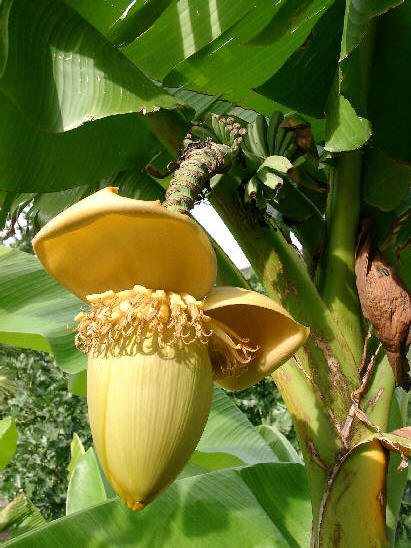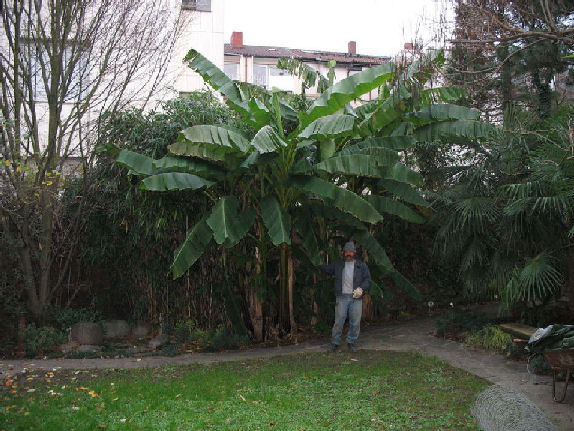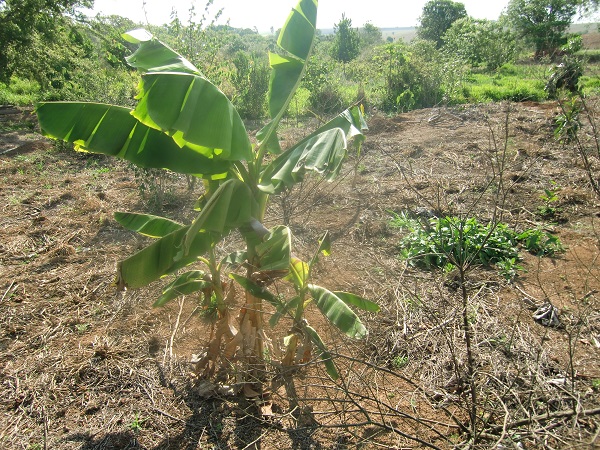

Musa basjoo
False Japanese Fiber Banana, Cold Hardy Banana, Garden Banana, Basjoo, German Banana
This is the most known cold hardy banana species of the section Musa in Europe, North America, Patagonia, Southern Brazil, Southern Argentinia, Southern Chile and in higher altitudes in the Andes, which is cultivated in Central Europe and Germany sinc e 19th Century. Where no other banana species can be cultivated outdoors, it does thrive and survives cold winters with snow and frost! Even in Rio Grande do Sul, Santa Catarina and in the higher altitudes of Paraná and São Paulo it could thrive without problems, where commercial banana cultivation is not possible more! Unfortunately it seems be hardly seen there, although it is one interesting ornamental banana for the coldest regions of Southern Brazil! Therefore the obtaining of our Musa basjoo 'Sakhalin' has proven as very difficulty in Brazil, but we could manage it, now one specimen stands in our garden in Lucianópolis and is grown very well and quickly! Recently Embrapa also made studies about many different banana species and also Musa basjoo was present!
It enjoys in the recent time of increasing popularity, there are already many outdoor locations in Germany, in Hamburg, Stuttgart, Wuppertal, Cologne, Baden-Baden, Freiburg, Dresden and other locations, also in Austria, Switzerland, United Kingdom, Netherlands, Belgium, Danemark and in many temperate and colder areas of North America and Europe. Even huge groves exist in Germany e. g. in the „Kölner Flora“ in Cologne, in the Botanical Garden of Tubingen and in Baden-Baden, also in some private gardens. Even in Southern Sweden are some outdoor sites.
The species name ‚basjoo’ is originated from the Japanese language, is derived phonetical from the Japanese word „basho“ for banana.
Musa basjoo grows in Brazil to 5.00 meters (17 feet) tall. The fruits are edible and are eaten in Japan as delicacy, they are small and therefore used like dessert bananas, when very good ripen, but does not taste for everyone. Unfortunately they are hardly usable in Europe and North America, because they don't ripe alright and are full of seeds, and they also taste bitter and dry. Crosses with Musa sikkimensis, Musa 'Prata', disease resistant new Brazilian cultivars and other species could change this.
Generally Musa basjoo is also called „Japanese Fiber Banana“, but it’s true, that in Southern Japan not Musa basjoo but Musa balbisiana is used for fiber production for sacks and ropes. Furthermore one has found in the recent times, that Musa basjoo self is not orginated from Japan but in China. Prohably merchants or seafarers brought suckers or seedlings of Musa basjoo to Japan hundreds or thousands of years ago, the species has etablished in Japan, so that also local cultivars formed, which are also specified more below.
Musa basjoo blooms in North America, Europe and Germany after mild winters outdoors with blooms, which are smelling after honey, if the pseudotrunks have survived the winter well wrapped. The then forming fruits don’t ripe in colder areas, apart from extreme cases, in these the bananas were provided with heated winter protection. Normally Musa basjoo dies back to the ground level and comes back from the corms every spring, usually in May. The foliage withstands frosts down to 27°F (-3°C) undamaged, the pseudotrunks clearly lower temperatures, there were pseudotrunks which survived 18°F (-9°C) with their heights of 5 to 7 feet (1.50 to 2.00 meters), the corms survive soil temperatures down to 10°F (-12°C) for short time. As young plant dies Musa basjoo always back, also when one tries to protect the pseudotrunks. But it grows very fast and can reach heights of more than 10 feet (3 meters) until August. However it’s recommended to mulch Musa basjoo well, so that the frost cannot run to the corm, for the case of one possibly extreme winter. There is also one situation, in which one Musa basjoo in Cologne/Germany at the border to Moutainish Land has survived ist first outdoor winter as extreme winter 1996/97, and that nearly without winter protection, because this was overblown by one storm. The specimen survived even 0°F (-18°C)! And it came back from the corm in the following spring. Today it’s a very beautiful huge banana, which is a eye catcher in the summer for the passing walkers. It’s one of the showiest banana trees in Germany. In Belgium have young plants of Musa basjoo survived already 10°F (-12°C) in one unheated greenhouse totally frozen (Penninckx, personally message).
There are further some cultivars of Musa basjoo existing, which are even some hardier than the regular Musa basjoo. That’s of allEs Musa basjoo ‚Sakhalin’ supposed from the south of the Russian Pazific island Sachalin and Musa basjoo ‚Sapporo’ from the Northern Japanese island Hokkaido from the area of the city Sapporo, which were imported to Germany in the past years. Already good experiences were made in the Upper Bavariad with the hardiness of Musa basjoo ‚Sapporo’. Even in the south of Scandinavia they could have good survival chances. The leaves of the both cultivars are some smaller than the of the regular Musa basjoo, the growth is slower and the end size with 7 to 10 feet (200 to 300 cm) at the end of the saison lies above the of the regular species. Both species regrow at leeast 2 to 3 weeks later from the corm than the regular species.
About Musa basjoo ‚Sakhalin’ one could even nearly says, that it could be a dwarf form of Musa basjoo. It grows only as tall as the not hardy famous Canary fruit banana ‚Dwarf Cavendish’, the famous and popular Canary Banana, has a shorter pseudotrunk, which is thicker than the of Musa basjoo. The leaves are only to 5 feet (1.50 m) long and to 2 feet (60 cm) wide, and have stronger leaf stalks, of all at the base, and are darkgreen. The plant has a closer leaf crown than Musa basjoo. It grows 40 precents slower than Musa basjoo, stops only in the winter completely. After English experiences the pseudotrunk should have survived even 19°F (-7°C) without damages, the leaves are as hardy as the of Musa basjoo. The corms are hardy to 10°F (-12°C), this cultivar has survived 10°F (-12°C) throughfrozen in one greenhouse in Belgium (Penninckx, pers. mess.).
In cold regions it’s recommended of that, because the peseudotrunk is to protect easier because of its smaller size. So that flowers and fruits are expected sooner. The better suitablity for smaller gardens is interesting, because there is fewer place required than for Musa basjoo.
In the recent time first specimens were blooming in Belgium, so that it could be found whether taxonomic differences between Musa basjoo and Musa basjoo ‚Sakhalin’ are existing, these are probable, if one DNA analysis does prove clearly differences from Musa basjoo. Then it would be might one new hardy Musa species.
The origin of this very hardy banana is not definitely clarified, there are two differently rumors existing. The first rumor tells about one Russian botanist, who was claimin g, he have brought the banana from the Russian island Sachalin in the north of Japan and have sold it to one English nursery. And the second tells, that one shipment of young plants from one airport on Sachalin was sold to one English nursery. Orgin sites on Sachalin are not probable.
This seems be suitable especially good for our cold hardy banana breed program and is the importantest species with the biggest frost resistance of all bananas, which still should be combinated with edible fruits. And it also earns one wider spread in Southern Brazil and in the southern countries of South America as ornamental banana.
I gave Helton in November 2011 some pups of my Musa basjoo ab, which has developed in Angatuba in his nursery very well and has even flowered and fruited, the seeds are open pollinated and not the pure species, because no another Musa basjoo in the male flower stage was present. Unfortunately the motherplant deteriorated and has died after transplanting onto the lawn into red clay soil and at the pondside, I parted it. But one pup appeared at the old place and I also transplanted the pup into red clay soil onto the lawn, in the direct neighbourhood of Musa thomsonii, there one direct hybridization between Musa basjoo and thomsonii might be possible. It was very well, that I gave Helton pups in November 2011!!! The red clay soil, the half shade and the near of the new water turm also could bring the plant to flower and fruit, so that I could make cross trials with pollination with pollen from parthenocarpic fruit bananas.

Close-up view of the inflorescence of Musa basjoo with forming fruits in the
Botanical Garden Mainz in Germany in northern summer 2005 (Photo:
Martin Engel, Germany)

Close-up view of nearly ripe fruits of Musa basjoo (Photo: Markku Häkkinen, Finland)

Musa basjoo in northern fall in Germany before the first frosts (Photo: Norbert Pohl, Germany)

The banana is covered high by foliage and garden waste and packed in Germany. (Photo: Norbert Pohl, Germany)

The winter protection of Musa basjoo in Germany. At the right is Trachycarpus fortunei, one palm species, which
grows in the milder regions of Germany and survives severe frosts. (Photo: Norbert Pohl, Germany)


The pup in Angatuba late October 2012..

.
Updated by Joachim Jaeck on October 10th, 2013